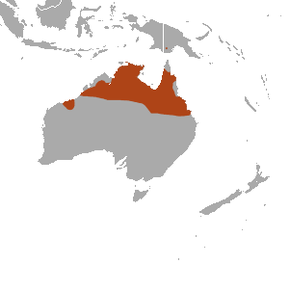bio.wikisort.org - Animal
Le wallaby-lièvre à lunettes (Lagorchestes conspicillatus; en anglais : le Spectacled Hare-wallaby ou le Mala) est un macropodidae vivant en Australie.
| Règne | Animalia |
|---|---|
| Embranchement | Chordata |
| Classe | Mammalia |
| Super-ordre | Marsupialia |
| Ordre | Diprotodontia |
| Famille | Macropodidae |
| Genre | Lagorchestes |
Espèce
Gould, 1842
Statut de conservation UICN

LC : Préoccupation mineure
Répartition géographique

On le trouve dans la moitié nord de l'Australie dans les régions de prairies à tussock ou spinifex. On peut le rencontrer du Queensland à l'Australie-Occidentale. C'est un animal solitaire, nocturne, herbivore, beaucoup plus grand que les autres espèces du même genre. Son pelage est gris brun avec les extrémités dorées et un cercle orange autour des yeux ce qui lui a valu son nom. Il construit son nid dans la végétation. Quand il se sent menacé, il s'enfuit en zigzaguant. Il a une portée d'un petit par an qui devient adulte vers l'âge de un an.
Références
- (en) Référence UICN : espèce Lagorchestes conspicillatus Gould, 1842 (consulté le )
- Groves, Colin () in Wilson, D. E., and Reeder, D. M. (eds) Mammal Species of the World. 3rd edition, Johns Hopkins University Press, 63. (ISBN 0-8018-8221-4).
- Australasian Marsupial & Monotreme Specialist Group (1996). Lagorchestes conspicillatus. 2006 IUCN Red List of Threatened Species. IUCN 2006. Retrieved on 2006-12-28.
- Menkhorst, Peter (2001) A Field Guide to the Mammals of Australia. Oxford University Press, 108.
- Whitfield, Philip (1998) The Simon & Schuster Encyclopedia of Animals. New York, Marshall Editions Development Limited, pg 28.
- Burbidge, Andrew A (2004). "4. Mammals", Threatened animals of Western Australia. Department of Conservation and Land Management, 64. (ISBN 0 7307 5549 5). “Vulnerable. 'Montebello Renewal', a Western Shield project, is eradicating feral cats and rats…”
- Portail des mammifères
- Portail de l’Australie
Другой контент может иметь иную лицензию. Перед использованием материалов сайта WikiSort.org внимательно изучите правила лицензирования конкретных элементов наполнения сайта.
WikiSort.org - проект по пересортировке и дополнению контента Википедии
